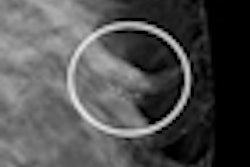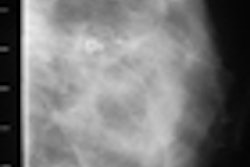The BI-RADS 3 classification for breast lesions -- "probably benign" -- is rarely used, and such lesions tend to have low malignancy rates. However, because many women don't comply with follow-up, radiologists must thoroughly evaluate lesions before classifying them as BI-RADS 3, according to a study in the July issue of Radiology.
The BI-RADS 3 category is typically used for 5% to 7% of suspicious lesions, with short-interval follow-up with mammography as the usual patient management strategy. But such a strategy can be complicated if patients simply don't return for follow-up mammograms.
Lead author Dr. Janet Baum of the Cambridge Health Alliance in Cambridge, MA, and colleagues evaluated how often the BI-RADS 3 category was used in the American College of Radiology Imaging Network (ACRIN) Digital Mammographic Imaging Screening Trial (DMIST). The team also assessed how often women actually returned for the recommended follow-up, and the rate and stages of malignancies found at follow-up (Radiology, July 2011, Vol. 260:1, pp. 61-67).
"Short-term follow-up recommendations do not work as intended if patients do not return for follow-up imaging," Baum and colleagues wrote. "Factors that reduce compliance are low educational level, low patient concern for cancer, poor general health, and race."
DMIST included a total of 47,599 evaluable subjects, each of whom underwent both digital and film-screen mammography. Baum's team identified women who were referred to short-term interval follow-up, and the group tracked each woman's compliance and the final outcome (malignancy diagnosis at biopsy, or no malignancy confirmed at follow-up).
Only a small percentage of the total DMIST cohort had tumors assigned a BI-RADS 3 category and were recommended for follow-up: 1,114 of the 47,599, or 2.3%. Of these 1,114 women, only 791 (71%) actually returned for short-term interval follow-up as requested. Of the women who did not comply, 226 (70%) of 323 returned for their next annual mammography screening exam, the authors wrote.
Nine women out of the 1,114 with tumors assigned a BI-RADS 3 category were found to have cancer. Of these nine, six were invasive (all less than 2 cm in size) and three were ductal carcinoma in situ (DCIS).
Short-interval follow-up is safe -- if they come
The study's results confirm the importance of completely evaluating a lesion before classifying it as probably benign, in light of the low patient compliance rate for follow-up.
"The most important finding in this study is the high percentage of noncompliance for women who were recommended to undergo short-interval follow-up," Baum and colleagues wrote. "Even in the context of this clinical trial, for women interested and concerned enough to participate, only 791 of 1,114 (71%) returned for their recommended short-term follow-up between three and 10 months after screening mammography."
But the study also shows that using the BI-RADS 3 classification and recommending short-term interval follow-up is a safe management strategy if used with care. Clinical literature has reported that if it's used correctly, the BI-RADS 3 category has a rate of malignancy lower than 2%; Baum's team found a malignancy rate of 0.81%.
The team noted that none of the women referred for short-interval follow-up without additional imaging after the screening examination were found to have cancer, suggesting that these lesions were of low suspicion. If patients had undergone additional imaging (BI-RADS 0) or if radiologists had trusted their judgment and classified the lesions as BI-RADS 2, short-interval follow-up could have been avoided.
"If you're not worried enough to call the patient back, classify the lesion as BI-RADS 2," Baum told AuntMinnie.com.
In any case, the study's findings support the view that short-term interval follow-up doesn't lead to clinically important delays in diagnosing breast cancer. But radiologists should be aware that a woman's compliance with the recommendation can put a wrench in the gears.
"The [BI-RADS 3] category can be appropriately utilized by breast imaging radiologists without substantial risk to women, but it continues to represent a compliance challenge," the authors concluded.




















